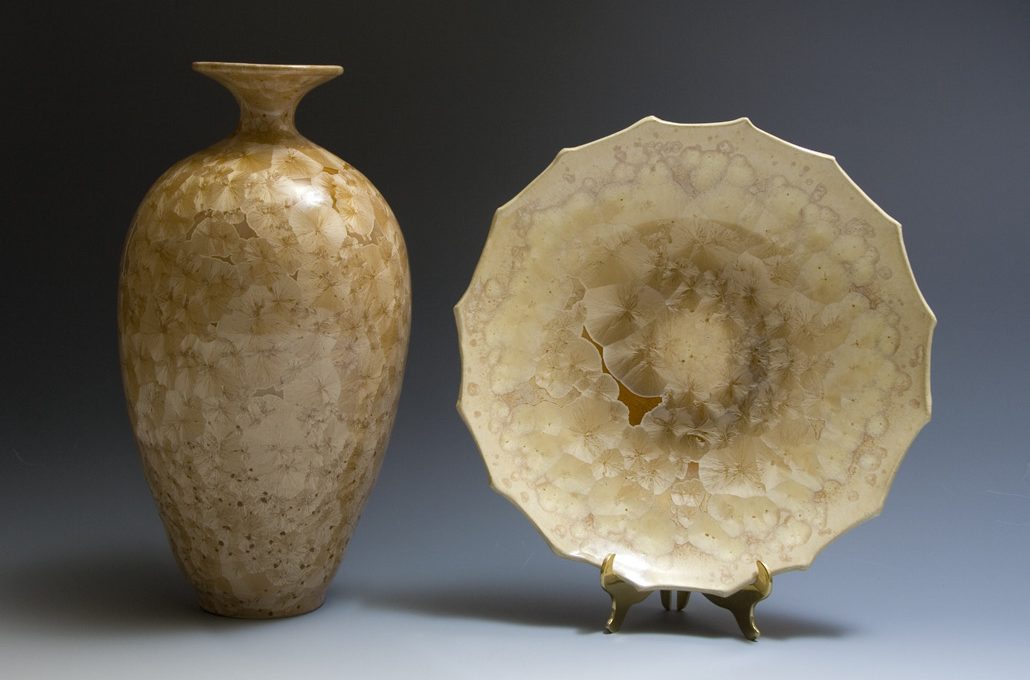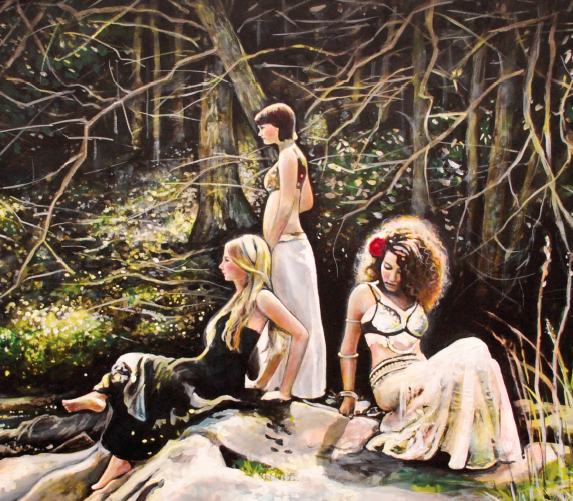This article was originally published in the second issue of VIA Noke Magazine, printed in Roanoke, Virginia in July 2012.
I consider myself fortunate to have recently spent an afternoon at the home and studio of local artist Steve Mitchell. After meeting Steve and discovering his unique style, I was excited to see where and how he worked to create his pottery. I excitedly followed him from his outside studio to his glazing workshop then to his homemade wood-firing kiln, leaving with a further understanding of the pottery-making process and a greater appreciation for the hard work ceramicists put into each piece.
EMILY: Tell me about yourself and how you began working with pottery. Did you have any formal education in ceramics?
STEVE: I went to East Tennessee State because they had a degree in transportation and I wanted to work for the railroad. But about the time I was graduating Norfolk Southern was laying people off left and right so I stayed another year and got a degree in marketing. When I came out I found a job in insurance. I was a manager of claims for Nationwide Insurance; it was a pretty stressful job. Nobody is ever having a good day when they call the claims department, so you’re not talking to them unless they’ve broken a leg or wrecked their car. So I decided to try pottery to unwind… or I should say again. I dated a potter a long time ago; I taught her how to do stained glass and she taught me pottery. I always thought, “I could do better than this.” And so about 25 years later I tried again over at the Brambleton Center, and this time I seemed to have more of a knack for it. So I got a wheel and the hobby started to kind of run wild. I would take my vacation time to go learn and take workshops from famous potters a couple of weeks a year. I did that for about ten years. Then I finally had a glaze formulation class where I learned to actually make my own glazes and the dynamics of glaze-making. About eight years later I decided, “I can do this,” so I decided to leave the company. Of course, now I’m always trying to do something that sells. For most potters, even though they don’t want to do production work, that’s what it’s all about. If you want to try to make a living doing this you have to produce a lot of work. There’s no way around it.
EMILY: So you make all of your own glazes?
STEVE: I do. I was rotten at chemistry in school so this is my punishment, because this is “chemistry world.” That’s what all of this is about; how materials react with other materials.
There are all kinds of borates, feldspars, nephelite; these are naturally mined clays and they come from particular mines. There’s a clay called “Albany clay,” or Albany slip. It was mined in Albany, New York and was the only true black clay. All of these people built their entire production around that one glaze, but they ran out of it and it’s not available anymore. That was the only place on the planet where that particular clay was found. Fortunately all of the clay that I’ve used for my work has come from the same place. But I had that happen to a frit from Germany. They all have this thumbprint, a profile of their chemical analysis, so I broke it down to its chemical base and I took all of the raw materials and made that frit myself. It took me two years to get it just right.
“I broke it down to its chemical base and I took all of the raw materials and made that frit myself. It took me two years to get it just right. “
There’s ilmenite, manganese, tin oxide, vanadium pentoxide, all of these weird – some of them rare – earth metals that are used to make the colors that I have in my glazes. For most people, the first thing they’re attracted to is the color, and hopefully later they fall in love with the form and the details and all of that. So I have most of the spectrum of materials for glaze making. I have at least 5lbs of almost every element on the earth, and 50lbs of most of them.
Some glazes are activated by salt, which is entered into the kiln at about 2300º; it turns into a gas, vaporizes, and swirls around in the kiln and puts a glaze over everything. Back in the old days that’s how they glazed pots, from natural fly ash or salt. I have always fired at cone 10, 2350º, but it’s a very slow process. I met a guy at a workshop who told me, “All of the things you do at cone 10 you can do at cone 6,” which is quite a bit cooler. So I gave it a shot, and sure enough… the ash melts at cone 6, salt turns into a gas at cone 6, but it saves half of the wood. It takes me as long and as much firewood to go from cone 6 to cone 10 as it takes just to get to cone 6, so this cuts my time and wood use in half. I’m reformulating all of my glazes so that they work at cone 6, which just means using different fluxing agents. I’m now using minerals that oddly I had but hadn’t really used before.

EMILY: Do you have a signature style or create any signature pieces?
STEVE: You have to do something to distinguish yourself or you’re not going to sell anything. The horsehair pots I make are about two to three times larger than a lot of potters will make them. For those I glaze the inside red and the outside snow white. I heat the pot up to about a thousand degrees, 1100ºF actually, and as it cools down there is about a fifty degree window where I can stick a piece of coarse horse hair in and burn a little carbon trail into the white clay. Interior designers really like that black, white, and red.

I have a wood firing kiln as well as an electric kiln so for about six months of the year I do the wood firing work and for the other six months I do my crystalline work in the electric kiln. Chemistry and the temperature cycle create the crystalline. The glaze solution is made up of 25% zinc, which is what they use to create the crystalline pattern on galvanized metal. Zinc wants to go into a crystallized formation, but needs a little bit of a catalyst, which in this case is titanium dioxide. You put a little bit of that in the glaze and coat it on pretty thick. At 2350º the glaze gets real loose and starts flowing off the pot into a tray underneath. I crash cool it down to about 1900º and that solidifies it a bit. At that point the zinc starts flowing towards the titanium dioxide molecules and the crystals will start growing. The longer you let it sit at that temperature the bigger the crystals will get.
It’s a lot of work to get a crystal on any pot. On some the crystals get too big and all run together. I don’t like that but it’s funny, some people really like when the crystals grow together. If I don’t like them they usually end up in the ditch. All potters have a ditch; it’s where the stuff that doesn’t work out very well ends up. If there’s something that I’m not pleased about but someone might like it I’ll throw it in my sale instead. So someone will ask, “What’s wrong with this one?” and I’ll say, “Oh it didn’t do what I wanted it to do.” And they think it’s perfect so they’re excited that they get it for 70% off.
I use Indian wood blocks to create patterns on some pieces. I think the wood is made out of some kind of teak or mahogany, but [the carvers] sit there with little knives and carve these little patterns into the wood blocks; it just seems amazing to me. They use them to print batik fabric, or wallpaper some people say. I stamp the clay and stretch it out to creates texture. You can line them up carefully and never see where the pattern starts and stops. What I like about it is that you get this natural, irregular feel to these pieces.
I’m working on a thing called “terra sigillata.” It’s something that the Greeks kind of came across by accident. You put the clay in a bucket and use a deflocculant – they used vinegars, I use a silicate – and it causes all of the particles to deflect each other so they don’t settle. I mix it up, let it set overnight, and the next morning all of the big particles are at the bottom and the super-fine particles are all in the solution on top. You can dip the pots or spray it on and then polish it on the wheel. The fine particles create an almost enamel-like surface. I’m thinking my next generation of pots will be like that.

I went to France with a friend of mine who was a wine importer and we went around France tasting all kinds of different wines from different regions. We got down to the Loire Valley to see Marc Ollivier, who is like the rockstar of the Loire Valley in winemaking. So I introduced myself, “Steve Mitchell, potier,” and he responded, “Potier!? My great, great grandpa potier!” And he runs out of this beautiful stone and walnut cellar into this huge mansion and he comes back down with this roughly hand-shaped crachoir, or spittoon. And he goes, “You make?” and I say, “Yeah, I can make!” So I came back home and made like a hundred of them, large and small. I’ve actually sold a bunch. I have a friend who went to Gascony, France and there was one of my crachoirs sitting on the bar; he took a picture of it and sent it to me. So I have them all over. I have a lot of them in Washington and Oregon because there are a lot of winemakers there. It’s a piece that I make that not many people really know much about.
EMILY: Tell me about your wood firing kiln.
STEVE: I was renting a kiln and fired it about ten times, at the average cost of a thousand bucks a pop, and I thought, “You know what? I can go home and build one.” The bricks are 8lbs a piece and there are probably about 6,000 of them. The first chamber is the initial woodburning chamber and the middle one is the first lair chamber. You stack ware all the way up to the ceiling and then brick it up to close it off. The third chamber is the salt chamber. Salt eats into the firebrick and gives them this finite life; that’s why I was paying to use that other kiln, because you’re literally wearing it out as you’re firing. I researched this for two years before I built it; I made hundreds of drawings. There are places where I mortared, but most of it is just dry-stacked.
My kiln will hold about 350 pots, but with the larger sizes I make it will hold about 80 per chamber. I throw pretty fast; I’ll spend 6 weeks throwing and making all of the pots I’m going to make and I’ll spend another month glazing them and getting them ready for the kiln. Then I’ll spend another month splitting wood. In one week I’ll load the kiln, seal up all the doors, get everything cleaned up and ready, and then I have a crew of guys that also fire pots in here come in to help. We’ll fire it all over a two-day period. A lot of wood firings take about three days. We do 8-hour shifts and rotate. You’re up most of that time, but if you get a reliable crew who knows what they’re doing you can go to sleep for a few hours, maybe four or five at a time. It takes a lot of work; some people just don’t know.
EMILY: Where can people find your work or how can they reach you?
STEVE: My website is www.stevemitchellpottery.com and people are welcome to contact me to come by the studio and gallery.
Some Helpful Ceramics Terminology
- Cone: Usually simply referred to as cones, pyrometric cones are used to measure the effect of the kiln’s atmosphere on the glazes being fired. Cones are made up of refractories, such as silica, and melting agents; each type of cone is carefully formulated and manufactured for accuracy. Rather than talking about temperature, potters almost always refer to the cone a pot is fired to. Cone numbers go from cone 022 to cone 14, with numbers beginning with a zero being of lower temperature than those without. (via about.com)
- Frit: A glaze material which is derived from flux and silica which are melted together and reground into a fine powder.
- Glaze: A thin coating of glass. An impervious silicate coating, which is developed in clay ware by the fusion under heat of inorganic materials.
- Kiln: A furnace of refractory clay bricks for firing pottery and for fusing glass.
- Slip: Clay mixed with water with a thick consistency. Used in casting and decoration.
- Definitions via jnevins.com/glossary.htm




